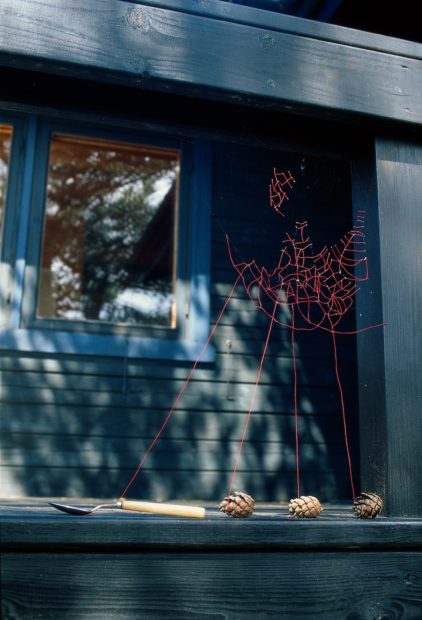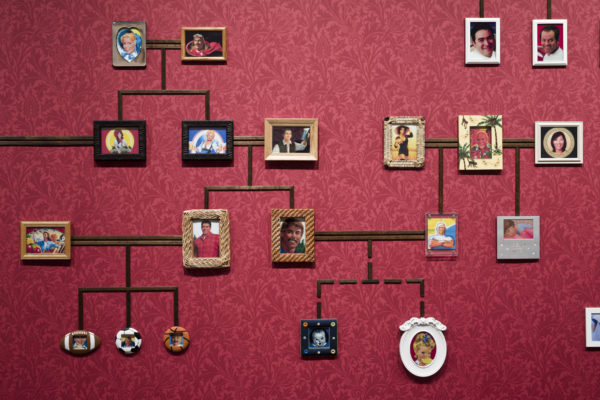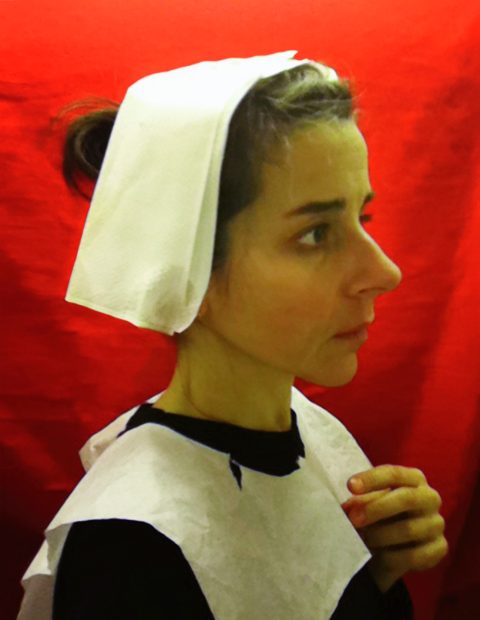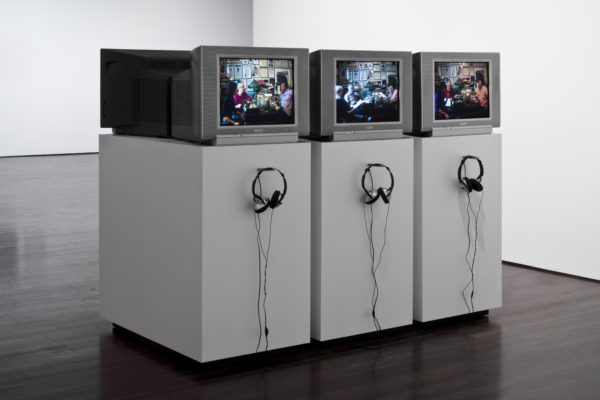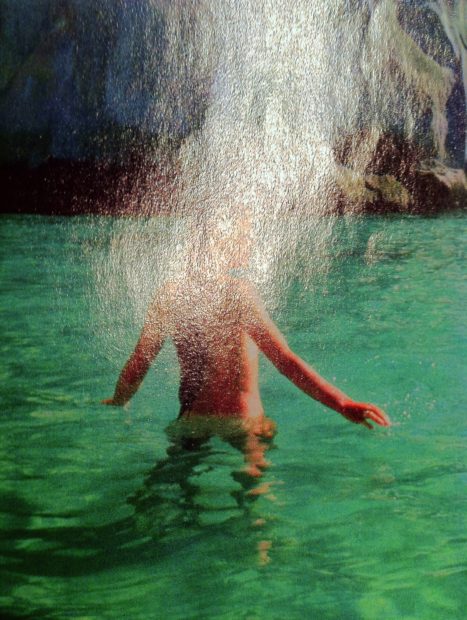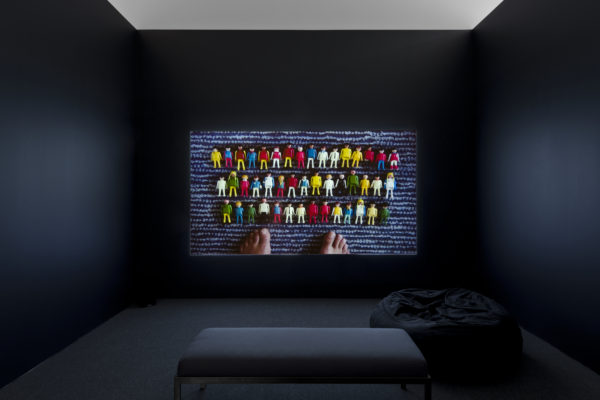The first time I encountered Nina Katchadourian’s work was in a generic-looking book about contemporary photography, where I happened upon Mended Spiderwebs. I was struck by the poignancy, intricacy, and absurdity of her attempt to assist a creature that can be a source of fear for so many. I imagined her fingers and a needle weaving through the lattice of the web, a patient hand leaving behind a remarkable trace of human presence with red thread. Five years ago, I met her and was struck by how grounded, kind, generous, and so utterly human she was in person. By then I was more familiar Katchadourian’s work and its side-splitting wit and play. Yet the humor in her work echoes some of our most pressing current cultural issues.
Now, nearly five years later, she walked me through her current show at the Blanton Museum of Art in Austin, titled Curiouser, and afterward we discussed the ways in which she herself has become the spider who is constantly weaving webs of her own with her work.
This interview has been edited and condensed for length and clarity.
Ayden LeRoux: Humor is really prevalent in your work, but my suspicion is that there’s something deeper going on. What’s beneath the surface when people chuckle at you singing David Bowie?
Nina Katchadourian: To take up your example of Under Pressure, I wanted to see if while watching it you could take someone from being in a place where they’re mostly amused by the strangeness of the situation—me lip-synching a song in costume in an airplane bathroom—to where that performance could really be affecting. The challenge was to see if I could make something that would sneak up on people. I’ve found it really satisfying when people say, “It’s such a strange thing to say about that video, but I found it really moving.” I’m setting up the expectation that this is a sort of absurd performance, but then it turns into something more wrenching and more serious.
I’m never trying to make things that are funny. That’s not the point. I think my primary and most consistent inquiry is really about what’s out there that we’re around all the time that can be more interesting than we imagine. There’s more to look at, more to engage, more to think about, and more to think harder about. The kind of humor that I’m often interested in is an everyday kind of humor. It’s an open, generous, kind of “come on in” stance. It’s not a good enough piece if a person would walk away and say, “That was funny.” That’s not enough.
A different example that I can pick is Genealogy of the Supermarket, which initially seems mostly like a fun game of matchmaking between these familiar faces [on various products]. How can I get all these people to interrelate? But I have to say, the more time I spent making this piece the more something else started to show up, which I hadn’t exactly expected. It’s about a sort of fantasy within this country about origins and roots and family and where people come from. More recently towards the bottom of the tree there are a lot of products I’ve been finding, especially of children, where there’s a sort of racial makeup to the physiognomy of the face that is very interesting and ambiguous. It’s a mixed-race face and I think that’s extremely telling at the moment. What does the average consumer right now in this country look like? It’s not a white European face anymore. A couple of older works [like Accent Elimination and Genealogy of the Supermarket] that have been around already for a long time have been shown and suddenly people are reacting to them with a very different context. The work has completely changed and taken on a very different set of readings.
Something can be very funny and still be very meaningful. If you want to cast the funny against the serious, the challenge for me is to get both those experiences to happen within the same piece. You’d be surprised how much the general investment in the art world is this very romantic expectation about what serious art looks like and how it behaves.
AL: I agree, and some people use humor as a tool, but it seems to me like what you’re doing isn’t employed as an overt first intention of the work. I know you also bristle at the word ‘whimsy.’
NK: I’m constantly saying somewhat defensively that funny and frivolous are not the same thing. Humor is a strategy. I’m very aware and in control of these decisions. I know humor can make someone curiouser and it’s useful on a lot of levels. It’s useful as a hook and it puts people at ease, and then once you have people at ease, you can do something else to them.
AL: It disarms them.
NK: I know that sounds sort of manipulative but in some sense as a viewer now some of my favorite works are the works which gently manipulate me—manipulate is such a loaded word… .
AL: They guide you.
NK: My initial expectations are off, and a piece ends up being about something else entirely.
AL: What do you think that beauty and humor have in common?
NK: What beauty and humor often have in common is that you are simply helpless in the face of it. It acts on you before you’ve even realized it’s happened. It bowls you over. It’s a little like wonder or other kinds of emotions where before you have a chance to intellectualize it, it’s already done it to you. There’s an immediacy or response despite yourself. Your emotions arrive before your brain decides whether it’s okay. As someone who looks at a lot of art, you must often also experience this, but I’m sometimes looking at work and I’m like “Should I be liking this or not?” and it’s not a question of “Do I?” as an evaluation of my own response which is happening at the same time.
AL: As when you’re thinking about your feelings. Or you have feelings about your feelings.
NK: Right, it’s this meta thing, which sometimes is so annoying. It’s so irritating sometimes to feel like I’ve been overly trained. One of the reasons I really like going to see dance is the pleasure of being outside my proper discipline and being allowed to like something or not like something without being “responsible” about it.
AL: That’s exactly why I love listening to jazz music; I’m blissfully ignorant about technicalities in music. It’s really reduced to the impulse of ‘do I like this or not?’ .
NK: Not that I would argue that knowledge ultimately ruins anything, either, but it’s just that as a practitioner it’s really hard for me to stand in an art gallery and not also be evaluating things as a person in the field. It’s so nice [when] there’s nothing at stake for me.
AL: More than half of the projects in that show are open-ended. They’re ongoing questions and I love the idea of you doing so many different things at once because it represents this belief that’s pretty different from many artists who are forced to work in one series to recreate and mimic that same tone for their entire careers. What you’re doing is this sprawling antithesis to that mentality and expectation of the art market.
NK: Yes, those projects are humming along in the background until there’s an opportunity to add to them, or some kind of deadline rolls around. This is oblique to your question, but you know the Dust Gathering project I did at MoMA?
AL: I loved that project; you brought a really refreshing work to MoMA. It felt a little sacrilegious.
NK: It does feel like I got to be a little naughty there. After working on this project, in this really nice way MoMA just feels like a big dusty house now. It’s brought it down to earth in a nice way for me. Not that I still don’t walk in there and feel some combination of enthusiasm, competition, wonder, and professional anxiety or whatever, but it’s been really, really satisfying to hear people say it’s changed their experience of that space and that they walk by a Picasso to look at the dust on the windowsill. A few friends have said it’s funny to be staring a ledge with dust on it and not to be looking at the art.
Back to the question of more serious content, the other really important thing with that piece is that it’s in a gentle way about labor and effort and the people who are not recognized for the work they put into that place.
AL: And visibility! I don’t want to sound trite but in some ways you’re the spider weaving the web and so much of what I loved about that piece was that it felt really connected to the mending of spider webs. There’s poetry in those two projects that elevates the work. That elegance and getting into these very detailed moments like seeing all the colors that are within the fibers of dust under the microscope… .
NK: There was this one day at the Blanton where I was hanging up the postcards and had this moment where I was like, “Oh my God, I’m the spider!”
AL: I’m curious too, what spaces you feel drawn to work in now and what does your studio practice look like because so much of your work is really about being out in the world and making work? I loved the quote in your book Curiouser where you said your camera phone is like your sketchbook.
NK: It’s the first time in a while where I don’t have a lot of deadlines and the best thing I can do is try to be as absorbent as possible in these moments, so I don’t think this summer is going to be about making anything at all. Working on the book [for the show] has made me realize how long the subject of shipwrecks has been on my mind. My personal interest in that coincides with a global political moment where a lot of people are doing drastic sea travel. I keep thinking there’s something about that right now that might make it a good time to try to think about shipwrecks more closely.
AL: How is it with things like that––that you know have fertile ground in your mind but you haven’t quite seen it from the right angle yet––you get to that moment where you’re ready to make work about them? Especially since so much of what you talk about is wanting to be really attentive and look at the world more closely.
NK: There’s an external kind of looking that generates a lot of projects, but other projects have a more internal approach—trying to think about something that tenaciously has it’s hooks in me for a long time.
AL: How do you train yourself to know how to follow your curiosity?
NK: [laughs] It’s a curious, delicate dance. The thing I heard in grad school more than anything else from my advisors in my first year was: “Quit talking yourself out of stuff.” I’d show up to meetings and say, “I have this idea, but you know it’s probably not a good idea, and it’s probably not gonna work because of this or that,” and my professors would say, “You haven’t even started yet! Don’t already say it’s a failure if you haven’t even tried to see where this might go.” I have to be patient with myself; sometimes it isn’t time yet. The Recarcassing Ceremony film, which I finally made last year took… I made a first attempt to make a project about that in graduate school over 23 years ago, where I first tried to approach that topic. It was just not time yet.
Through June 11, 2017 at the Blanton Museum of Art, Austin.


